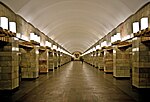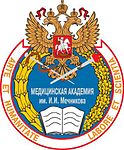Murino, Leningrad Oblast
Cities and towns in Leningrad OblastSankt-Peterburgsky UyezdUse mdy dates from June 2018Vsevolozhsky District

Murino (Russian: Мурино [ˈmurʲɪnə]) is a town in Vsevolozhsky District of Leningrad Oblast, Russia, located east of and immediately adjacent to the city of St. Petersburg. Formerly a settlement, it was granted a town status on 27 March 2019. The population estimates of Murino are about 50 thousand.
Excerpt from the Wikipedia article Murino, Leningrad Oblast (License: CC BY-SA 3.0, Authors, Images).Murino, Leningrad Oblast
Центральная улица, Муринское городское поселение
Geographical coordinates (GPS) Address Nearby Places Show on map
Geographical coordinates (GPS)
| Latitude | Longitude |
|---|---|
| N 60.045833333333 ° | E 30.451388888889 ° |
Address
Центральная улица
Центральная улица
188662 Муринское городское поселение, Медвежий Стан
Leningrad oblast, Russia
Open on Google Maps











